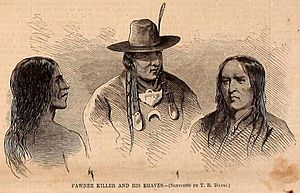Pawnee Killer facts for kids

Pawnee Killer was an important leader of the Oglala Lakota people. He was born in 1826. He also led a group of brave warriors known as the Dog Soldiers. This group included both Sioux and Cheyenne people. Pawnee Killer fought during the American Indian Wars, a time when the US Army fought against Native American tribes on the Great Plains.
Contents
Who Was Pawnee Killer?
Pawnee Killer was a respected leader among the Oglala Lakota. The Oglala are one of the seven groups of the Lakota people. They lived on the Great Plains of North America. Leaders like Pawnee Killer guided their people and warriors during important times.
Why His Name?
Pawnee Killer's name came from his success in battles against the Pawnee people. The Pawnee were another Native American tribe. They were often rivals of the Oglala Lakota. The Pawnee also sometimes worked with the US government. His name showed his bravery and skill as a warrior.
Pawnee Killer's Role in Conflicts
Pawnee Killer took part in several important battles during the American Indian Wars. These conflicts shaped the history of the American West.
Battles and Skirmishes
He was involved in the attack on Julesburg in Colorado. He also fought in the famous Fetterman Fight in Wyoming. Both of these events happened during a conflict known as Red Cloud's War. This war was fought over control of lands and travel routes.
In 1867, Pawnee Killer also fought in what was called the Kidder fight in Kansas. He might have also been part of the Battle of Beecher Island in 1868. These battles were part of the ongoing struggles between Native American tribes and the US Army.
Life After the Wars
After the American-Sioux wars ended, Pawnee Killer settled down. He moved with his family to the Pine Ridge Indian Reservation in Nebraska. This reservation was part of the Red Cloud Agency.
Not much is known about his life after this time. However, his name appears on the reservation's official records. He was listed as the head of his household until June 1895. This shows he lived a quiet life on the reservation in his later years.

